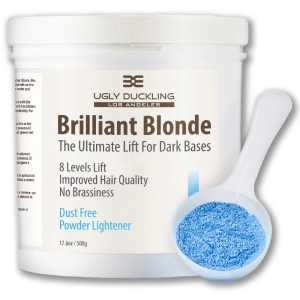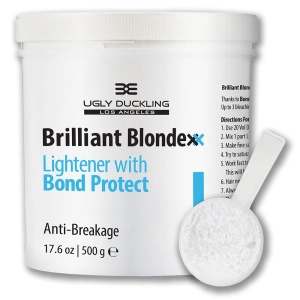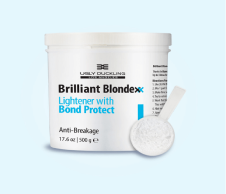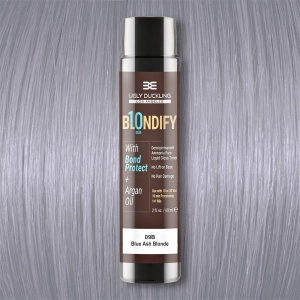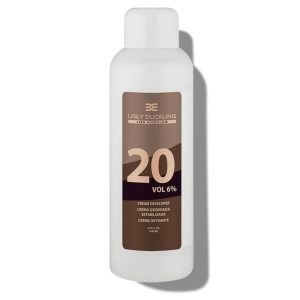People interested in bleaching hair—whether at home or professionally—frequently ask a set of recurring questions.
These typically revolve around safety, technique, product choice, timing, and aftercare.
In this blog we are going to go through some of the most common questions.
1. Is it safe to bleach your hair at home?
Many professionals strongly advise against home bleaching due to the risk of uneven results, breakage, scalp burns, and even permanent hair loss if done incorrectly. The chemicals involved, such as hydrogen peroxide are strong and can cause serious skin and eye irritation if mishandled.
What is important is that you use quality bleaching products and that you use them correctly.
At Ugly Duckling we recommend that you use one of these 2 bleaches:
Brilliant Blonde bleach is a blue based dust-free bleach. It is one of the strongest and fastest acting bleaches on the market. It is what we use to take dark hair all the way to level 10 blonde in just one sitting. Use this bleach when you have very dark, thick and difficult to lift hair.
Stylists looking to bleach Asian hair, Hispanic and dark frizzy hair (African or Indian for example) and looking for significant lift (7-10 levels, for example) should use this bleach.
Brilliant Blondexx is a white oil-based bleach which produces one of the creamiest mixes possible. It is enriched with Bond Protect. This bleach is what we would recommend for most European hair. It lifts very well, but gently.
You can use this bleach near the scalp because the Bond Protect will minimise skin or scalp irritation. Your client should experience greater bleaching comfort.
Most stylists looking for to bleach up to 7 levels and looking for lift plus hair bleaching quality should use this bleach.
See the chart below on hair lifting levels. Use this to decide how many levels you will be looking to lift today.
 Lightening_levels (1).png)
2. What products and tools do I need to bleach hair?
You would need a hair bleach powder, a developer (usually 20 or 30 volume hydrogen peroxide), a non-metallic mixing bowl, an applicator brush, gloves, sectioning clips, and protective clothing.
The choice of developer strength is really key, and this is where many trainee stylists fail.
The rule is to use 20 Vol developer when aiming to lift by up to 3 levels. Use 30 Vol developer when aiming to lift by more than that.
For the near scalp area, always use 20 Vol, because the hair will lift quickly there.
Also, in case the hair has not lifted enough the first time round, and you need to do a second application, use 20 Vol developer.
So in other words, you may need to keep 2 separate developer strengths at hand when you bleach.
That is how good stylists do bleach and how you should too.
3. How do I mix bleach and developer, and what ratio should I use?
The mix that we recommend is 1 part bleach to 2 parts developer.
This will give you a runny mixture which is what you need to get good product saturation.
Don't forget that when you bleach you literally need to drench the hair in bleaching solution.
That can't happen if the bleach mix is dry and flaky.
4. How should I apply bleach to my hair?
If you are doing a full head bleach and the entire head is one even color (for example you are bleaching virgin hair), then section dry, unwashed the hair into four parts for manageability.
Then start at the back, making mini sections out of one section.
Then work your way round to the sides and the front, where the hair is typically finer.
Save the root area until the end, because it will process faster there.When bleaching the roots, apply bleach starting about one half inch from the root itself. You don't need to place the mixture on the scalp itself.
If you are bleaching hair that has already been colored in the past, the rule is to start applying the bleach on the part where it is darkest.
Typically, this would be the root area, where there is regrowth.
Once that part has had bleach applied and is almost yellow, extend to other areas that are orange or yellow.
Your aim when bleaching should be to lift up everything to a uniform level 10 color.
Don't hesitate to make fresh mixes and reapply.Don't under-bleach.
If you do you will get left with orange or bright yellow hair which will not tone well.
Avoid overlapping onto already bleached hair, otherwise you can get severe hair damage.
If for some reason you do apply there by mistake, just wipe back with a damp cloth and you should be fine.
5. How long should I leave bleach on my hair?
Processing time varies based on hair color, texture, and product strength.
Generally, 20–40 minutes is typical. But above all it is not a question of time.
It is a question of getting the hair to the right level, which is level 10 blonde.
After applying bleach and waiting around 20 minutes, you need to peel back some of the mixture to check where your hair is at.
Only look to rinse when you see that the hair has clearly turned level 10 with no orange whatsoever.
See the pictures below of what your hair needs to look lack when it's been correctly bleached.
Until you get the hair there, you need to keep the bleach mix on, and keep it wet, re-applying fresh mix as required.
Peel back your bleach mixture to check the level

This hair still has some light orange in it and needs to be processed a few minutes more.
Bleach until the hair is a level 10 (very pale yellow color) and you will get outstanding results when you tone and blow dry.
Hair bleached to level 10 being rinsed at the backwash

6. What strength developer should I use?
Use 20 volume developer for lifts of 1–2 levels or for roots, and 30 volume for lifts of 3 levels or more, especially on mid-lengths and ends.
For very dark hair, a two-step approach (30 vol, then 20 vol) may be needed.
7. Can I bleach hair that’s already colored or previously bleached?
Yes, but expect a more challenging process, particularly if a lot of color has been deposited in the past.
Removing very dark color from colored hair may take longer to achieve the desired lift. If the hair has been colored and bleached many times, it could be porous and be very difficult to lift without breakage.
We always recommend a strand test before using bleach, and in the case of hair colored darker needing to be bleached this strand test will be critical in decision making.
8. How do I avoid hair breakage and minimize damage?
Avoid overlapping bleach on previously lightened hair.
Use a quality bleach, preferably bond-protecting bleaches such as Brilliant Blondexx.
Inspect hair quality and do s strand test before hand.
For most hair, bleaching is not hard and if you follow the right steps, you should be able to avoid damage totally.
Use a bond protect hair treatment product such as Brilliant Blondexx mask afterwards.
This will restore moisture and strength to the hair.
9. How do I perform a strand and skin test?
Take one small strand of hair and apply bleach mixture to it.
10. How often can I bleach my hair?
Bleach it once and do it right.
If you did it right you should not need to bleach it again.
Above all, don't try and bleach hair incrementally.
Stylists only do that because they don't know how to bleach or lack confidence.
The only bleach you will be using after that will be on the regrowth area at the roots.
11. Should I use foils when bleaching?
Foils help with even processing and are especially useful for dark hair or highlights.
They keep heat in and allow for faster, more controlled lifting. T
They are a good idea, especially for the first round of bleaching.
For a further application, you will probably be best advised taking off the foils and placing the mixture directly onto the hair, using fingers (and gloves) to rub in.
12. How do I tone the hair after bleaching?
Hair that has been bleached with Brilliant Blondexx and toned using Intense Pearl Blonde.

All bleached hair needs to be toned afterwards. Otherwise the bleached hair color will look raw and unsophisticated.
Ugly Duckling has a wide range of toners available. Both cream based toners with lift, as well as non-lifting ammonia-free toners.
Choose the most appropriate one for your needs.
And don't forget to combine a toner with Color Gel grey hair coverage liquid color if you have some grey hair in your hair.
This will allow you to tone and cover greys at the same time.
13. What aftercare does bleached hair require?
Use sulfate-free, nourishing shampoos and conditioners. Purple shampoos and purple masks such as Brilliant Blonde Shampoo and Mask wlll help you combat brassiness,
Use Brilliant Blondexx shampoo and mask to nourish the hair.


